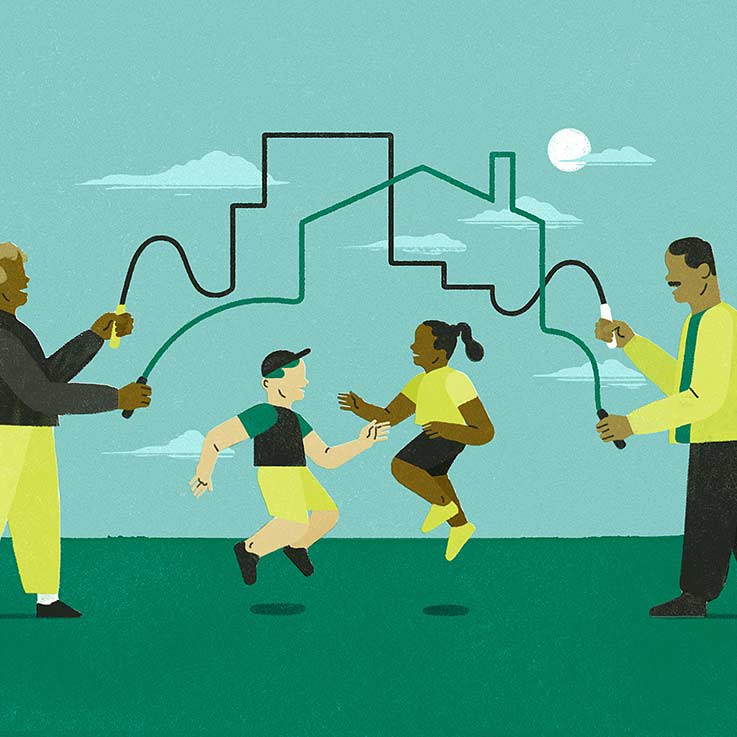
Give a Man a Fish, and You Feed Him for a Day. Give a Family Cash, and You Feed Them for…a While
Give a Man a Fish, and You Feed Him for a Day. Give a Family Cash, and You Feed Them for…a While
For all the glowing press that unconditional cash transfers (UCT) have gotten, cash is still a long way from living up to the hype and transforming the development sector.
By Kevin Starr Feb. 16, 2021
In the early 2010s, GiveDirectly gave the poorest households in rural western Kenya big unconditional cash transfers (UCTs), roughly equivalent to a year’s income. A year later, the result was that people were happier and better fed. They’d bought tin roofs and cows and other good stuff, and didn’t waste money on bad stuff. In the short term, giving really poor people a bunch of money left them a lot better off.
That’s not surprising. We already knew from lots of studies that poor people make good use of money, that easing acute stressors makes people happier, and that even a short-term escape from a scarcity mindset triggers all kinds of good things. But given Mulago’s mission of “lasting change at scale,” we wanted to know whether short-term benefits turn into lasting impact. Did this big infusion of cash change a family’s socio-economic trajectory over time?
Alas, it did not. At four years, the families that received GiveDirectly’s cash were not meaningfully better off than control families. While they had several years of increased consumption, everyone caught up to them four years later. Those short-term gains were sustained—nobody went backward—but as a slowly rising tide also elevated everyone else to the same level, it turned out be a temporary boost. Good things happened, but: this big infusion of money did not change their long-term trajectory, it didn’t seem to alter their lives in profound ways, and it didn’t lead to much in the way of lasting impact.
The initial, short-term results generated a ton of excitement when they came out; a lot of people thought that this would “transform the development sector,” and so forth. So, when the disappointing longer-term results came in, I thought that it would be a REALLY BIG DEAL. Those results splashed cold water on the whole “future of development” thing, right?
Nope. It was largely ignored, and the UCT train roared on down the track.
Now, people tend to lump different flavors of cash transfers together, even though they, and their effects, are often very different: conditional, unconditional, one-time, multiple, short-term, long-term, large, small, accompanied by other interventions, unaccompanied, and many combinations thereof. The GiveDirectly cash transfers were of the large, one-time, unconditional, unaccompanied-by-any-other-intervention variety (which, for grins, I’ll call a LOUT). Since, as far as I can tell, GiveDirectly are the only ones who have done this particular type, there is, so far, no evidence of lasting impact from this kind of UCT.
However, what if we think bigger? Thanks to a brilliantly conceived and executed study from Ted Miguel et al, we can now see what happens in a regional economy when you do a lot of LOUTs, in this case, $11 million worth in a region of 300,000 people and 650 communities. Like before, the results are pretty great a year later, and though the household effects are similar, it’s the regional effects that are most striking. The authors make a very persuasive case that 1) everybody was better off whether they got the cash or not, 2) the infusion had an impressive 2.7x multiplier effect within the local economy, and 3) nothing bad happened (this big spurt of money did not lead to inflation).
These are really important additions to the cash transfer literature—a 2.7 multiplier is nothing short of spectacular—and all three findings are going to have important policy implications over time. And of course the development media has responded with the same kind of headlines as in 2016, e.g. “A charity dropped a massive stimulus package on rural Kenya and transformed the economy” (It’s a great article, hyperbolic title aside). But for me, these study results raise the exact same question that the original household study did.
Does this result in lasting change? Is anything actually “transformed?”
I’m not an economist—it takes me about a week to get through one of these papers—but I don’t know if we are any more likely to see lasting change at the regional level than we did at the household level. The authors observed that much of the short-term impact was from the take-up of “slack” in the local economy, i.e. there was excess capacity that sprang into action once there was more cash floating around (for example, local mills had machinery and people sitting around under-utilized). The way they put it was that the improvements in the economy were “demand-led (consumption spending) rather than investment-led (productivity spending).”
We’ve seen that dropping a LOUT onto a household economy created a lot of short-term benefits, but it didn’t seem to create much in the way of lasting impact. Given that the observed change here is “demand-led,” I’m not sure why we think that a one-time injection of money into this impoverished rural economy would have much lasting effect either? This isn’t a previously robust economy that needs a stimulus kick in the pants to get it going again; we’re talking about an economy based on a commodity-crop smallholder poverty trap: hard-working people scratching a living from low-value crops on ever-smaller plots with continually worse soils. This means that people tend to be “default” farmers, who didn’t choose farming but are making use of the only asset they have (growing commercial crops is tricky and something that only a small percentage of these farmers even want to take on.)
Something needs to change the fundamentals here, and given that the economic mini-boom was driven by consumption, it seems unlikely that it will be this one-time bolus of cash. Investment is about tomorrow. When people are living so close to the bone, they need to spend that money for today.
The authors are way too on point not to be thinking about this “demand-led” issue and they suggest that a regional UCT could address the problem of liquidity traps:
“Other theoretical perspectives from international trade, economic geography, and development…as well as the liquidity traps literature mentioned above, would suggest there could be persistent local effects of a temporary cash infusion, due to agglomeration effects, increasing returns, changes in income inequality, market structure and firm specialization, and even shifts in the social networks of traders and suppliers.”
The problem is that liquidity traps are not the same as poverty traps. When the majority of the population is stuck in unproductive smallholder farming, the deck is stacked against all those “persistent local effects.” There’s a reason why proven “ultra-poverty graduation” programs provide people with a lot more than cash, and why those programs have been most successful in places like Bangladesh where the ultra-poor are a minority struggling within an otherwise lively economy. Poverty traps are stubborn things, especially when everyone around you is caught in it too.
If one-time cash seems unlikely to break the poverty trap logjam, maybe smaller amounts disbursed steadily over a longer period can create lasting change. In another illuminating recent study, Handa et al gave an unconditional $12 a month to Zambian families for three years, paid in two-week installments. Though it was a complex study, the paper is eminently readable: the upshot is that families were demonstrably better off, and that this steady, reliable trickle of money had a multiplier of 1.67 (meaning that each dollar distributed generated an additional 67 cents of income). And the kicker is that a UBI-style transfer like this might have more impact than a lump-sum LOUT of almost 2x the overall amount (or as much as other much more expensive poverty graduation programs).
That’s a really big deal, and maybe there is something magic about the steady, reliable trickle of cash that is more of a game-changer. Can a sustained increase in consumption drive second-order changes that have lasting effects? I dunno, but it’s impossible not worry that everything goes back to baseline when the cash tap is turned off. Clearly Handa’s three years of modest UBI did a lot of good and it’s hard to make the case that it’s not worth doing as long as 1) you can find someone to pay for it and 2) it’s not diverting money from something with more sustained impact (given the track record of some, ahem, Big Aid funders, a modest UBI might be a fine diversion).
But is it development? Can it change a family’s—or a region’s—long-term trajectory?
Having spent a lot of time trying to make sense of the best use of our foundation’s dough, I remain convinced that cash is about poverty mitigation, not development. I wouldn’t mind a bit if I turned out to be wrong; I’ve been banging my head against the wall for years trying to figure out the solution for stuck rural economies in places like western Kenya and rural Zambia and it’s not like I have a better answer.
But even though I don’t buy it, at least not yet, funders like Mulago should still pay close attention to cash studies. We have to be willing to shift resources if cash in whatever form turns out to have more impact than the kinds of solutions we currently fund—although really, I expect Mulago investments to perform a lot better. But even as we learn about the potential of cash—and these studies are proliferating like rabbits—it’s high time that proponents figure out where the money’s supposed to come from, at scale. As I wade through this stuff I have yet to read a substantive discussion of that problem, especially in the context of strapped governments in Africa. You’ve got to have a payer at scale: Way too many things get taken way too far before anybody figures out just who that’s gonna be. Don’t let this be one more.










